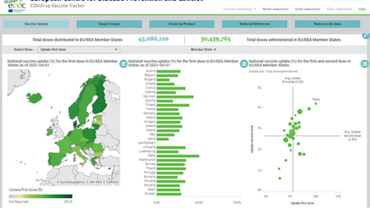Facilitating COVID-19 vaccination acceptance and uptake in the EU/EEA
This technical report presents considerations for European Union/European Economic Area (EU/EEA) countries when diagnosing barriers to acceptance and uptake of COVID-19 vaccination, and designing and implementing interventions to increase uptake. The report uses the ‘5Cs’ model to organise and explain the various causes of low vaccination acceptance and uptake, and to categorise potential interventions. The key concepts included in the 5Cs model are Confidence, Constraints, Complacency, Calculation, and Collective responsibility. In addition to discussing the facilitation of COVID-19 vaccination for the general population within this framework, specific population groups have also been included in the report, such as healthcare workers and socio-economically vulnerable groups. Given that eligibility for vaccination has been extended to children and adolescents in many countries, parents are also included as a group.
The report highlights the importance of diagnosing the drivers of sub-optimal vaccine acceptance and uptake in a given population to ensure that appropriate interventions are implemented in response. It also presents examples of interventions that have been implemented in the EU/EEA, any of which could be adapted for use in other settings where similar drivers of low vaccination uptake have been identified. Finally, the report discusses the importance of evaluating interventions to increase COVID-19 vaccine uptake, as well as some of challenges associated with such evaluations. Resources for diagnosis, implementation and evaluation that may be used by EU/EEA countries are also included in the report.
Executive Summary
Key messages
- A successful COVID-19 vaccination programme can only be built on an understanding of, and a proper response to individuals’ and communities’ beliefs, concerns and expectations regarding the vaccine and the disease. The ‘5Cs’ model – Confidence, Constraints, Complacency, Calculation, and Collective responsibility – can be used as a framework for understanding these concerns and designing strategies to facilitate COVID-19 vaccination acceptance and uptake.
- Taking the 5Cs model as a basis, the drivers of low vaccination acceptance and uptake can be diagnosed by analysing cross-sectional, population-level data. The World Health Organization’s Regional Office for Europe has developed a survey tool on behavioural insights relating to COVID-19 which can be used for this purpose. Collaboration with civil society may also offer the possibility to leverage operational data – quantitative and/or qualitative – that may provide insights into individuals’ and communities’ vaccination beliefs, concerns and expectations.
- Vaccination efforts in many countries are currently focussing on reaching pockets of unvaccinated people from older age groups and those in socially-vulnerable populations, while also facilitating uptake among younger age groups (including children and adolescents who are eligible for vaccination). Healthcare workers have a key role to play in this work. The specific challenges faced by each of these groups in accepting, accessing (and, for healthcare workers, facilitating) vaccination need to be properly understood and addressed.
- This document presents examples of some of the measures being implemented by countries to increase vaccine acceptance and uptake, depending on the drivers identified in a given context. They may need to be adapted at sub-national or local level – there is no ‘one-size-fits-all’ approach. Drivers can also change over time, which means that diagnoses may need to be repeated on a regular basis.
- Many of the interventions reviewed for this report focused on the provision of accessible services, often paired with accompanying risk communication strategies. Some countries have also opted for measures based on incentives and sanctions. Fewer strategies were identified that aimed to build trust in the healthcare system and engage with communities.
- Establishing the effectiveness of an intervention to facilitate vaccination acceptance and uptake is methodologically challenging. Good evaluations of these interventions can still be conducted, using both quantitative and qualitative data, although the findings from process evaluations will generally be easier to interpret than those from impact evaluations.
Download

Read more
News story
ECDC supports Member States to increase COVID-19 vaccination acceptance and uptake in the EU/EEA
On October 15, ECDC published the report “Facilitating COVID-19 vaccination acceptance and uptake in the EU/EEA” which aims to further support Member States in identifying barriers to the uptake of COVID-19 vaccination, and designing and implementing interventions aimed at increasing vaccination coverage.
Infographic
Infographic: Facilitating COVID-19 vaccination acceptance and uptake
This infographic shows the barriers to the uptake of COVID-19 vaccination.
Video
Video: Five C's to boost COVID-19 vaccination
John Kinsman, expert on behaviour change, explains the key points of ECDC's report on facilitating COVID-19 vaccination acceptance and uptake in the EU/EEA, published on 15 October 2021.







